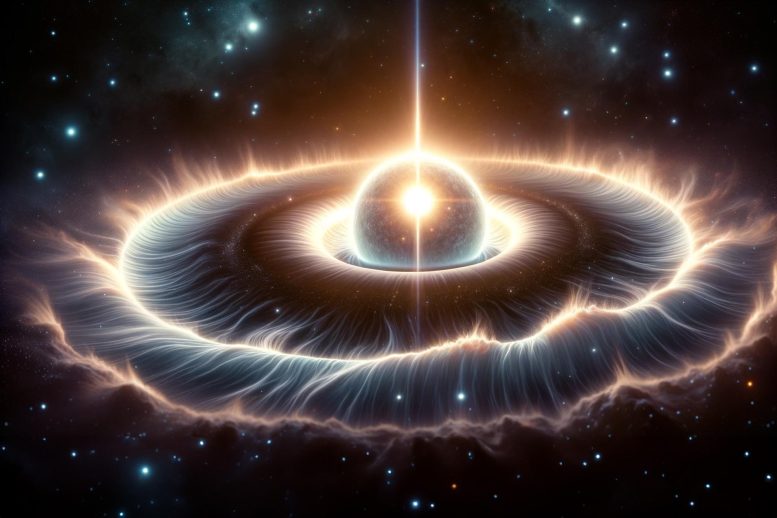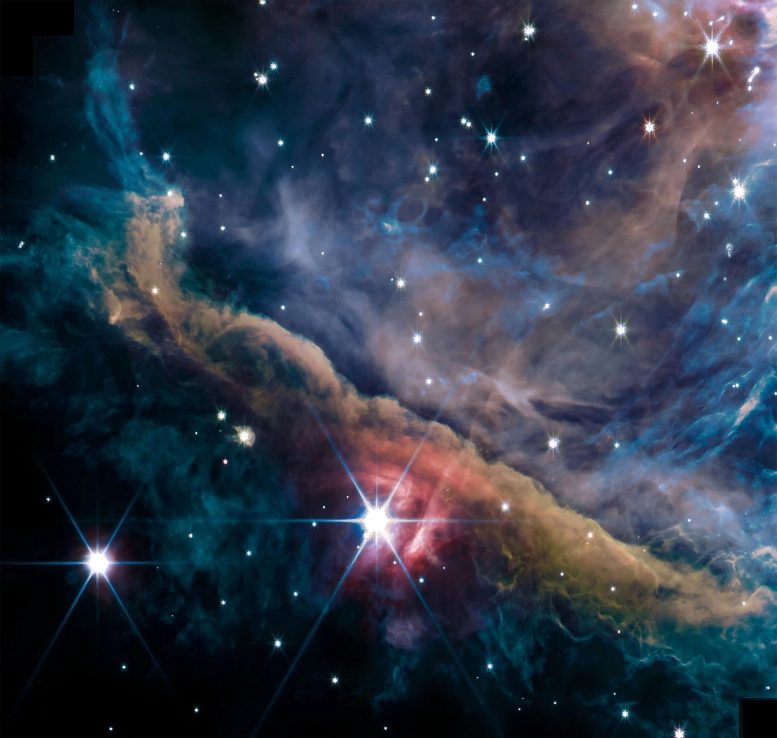
Research using the James Webb Space Telescope has provided the first direct evidence that ultraviolet “winds” from nearby massive stars can cause rapid mass loss in young star protoplanetary disks through FUV-induced photoevaporation. (Artist’s concept.) Source: SciTechDaily.com
Research utilized james webb space telescope We highlight the destructive power of ultraviolet “winds” on the gas of protoplanetary disks surrounding young stars, and highlight the complex dynamics that limit the formation of gas giants in the universe.
A new study shows that ultraviolet “winds” from nearby massive stars strip gas from young stars’ protoplanetary disks, rapidly reducing their mass. This reports the first direct observational evidence for deep ultraviolet (FUV)-induced photoevaporation of a protoplanetary disk. This discovery, using observations from the James Webb Space Telescope (JWST), provides new insight into the constraints on gas giant planet formation, including in our solar system.
Insights into gas giant planet formation
Young low-mass stars are often surrounded by relatively short-lived protoplanetary disks and gas that provide the raw materials from which planets form. The formation of gas giant planets is therefore limited by processes that remove mass from the protoplanetary disk, such as photoevaporation. Photoevaporation occurs when the upper layers of a protoplanetary disk are heated by X-rays or ultraviolet protons, causing the gas temperature to rise and forcing the gas to escape the system. Because most low-mass stars form in clusters containing massive stars, protoplanetary disks are expected to be exposed to external radiation and experience ultraviolet-induced photoevaporation.


The inner region of the Orion Nebula as seen by the James Webb Space Telescope’s NIRCam instrument. Source: NASA, ESA, CSA, data reduction and analysis: PDRs4All ERS team; Graphics processing S. Fuenmayor
Observational evidence from JWST and ALMA
Theoretical models predict that deep ultraviolet radiation produces photodissociation regions (PDRs). The photodissociation region is a region where ultraviolet photons emitted by nearby massive stars have a significant impact on the gas chemistry at the surface of the protoplanetary disk. However, it is difficult to observe these processes directly.
Olivier Berné and colleagues reported observations of the FUV-irradiated protoplanetary disk d203-506 located inside the Orion Nebula using near-infrared and submillimeter measurements from JWST and the Atacama Large Millimeter Array (ALMA), respectively. By modeling the excitation and kinematics of the emission lines detected within the PDR, the researchers found that d203-506 is losing mass at a rapid rate due to heating and ionization by the FUV.
According to the study, the rate at which this mass is lost from d203-506 indicates that gas could be removed from the disk within a million years, suppressing the ability of gas giants to form within the system. “Dynamics and composition studies of the solar system show that it formed in a cluster containing one or more massive stars and therefore may have been affected by FUV radiation,” Berné said. except. write.
For more information about this discovery, see:
References: Olivier Berne, Emilie Habart, Els Peeters, Ilane Schroetter, Amelie Canin, Ameek Sidhu, Ryan Chown, Emeric Bron, Thomas J. Haworth, and Pamela Klaassen, “Far-ultraviolet-driven photoevaporation flows observed in protoplanetary disks” 2010 ; Boris Trahin, Dries van der Putte, Philippe Alarcon, Marion Giannese, Alain Abergel, Edwin A. Bergin, Jérôme Bernard-Salas, Christian Boersma, Jan Cammy, Sarah Square, Emmanuel d’Artois, Daniel Dicken. , Meryem Eliazzuri, Home Fountains, Javier R Goicoechea, Karl D. Gordon, Lina Issa, Christine Joblin, Olga Kannavou, Baria Khan, Ozan Lacinbala, David Languignon, Romane Le Gal, Alexandros Maragkoudakis, Raphael Meshaka, Yoko Okada, Takashi Onaka , Sofia Pasquini, Marc W. Pound, Massimo Robberto, Markus Rollig, Bethany Schefter, Thibaut Schirmer, Thomas Simmer, Benoit Tabone, Alexander GGM Tielens, Sylvia Vicente, Mark G. Wolfire, PDRs4All Team†, Isabel German, Louis Allamandola, Rebecca Auchettl, Giuseppe Antonio Baratta, Clement Baruteau, Salma Bejaoui, Partha P. Bera, John H. Black, Francois Boulanger, Jordy Bouwman, Bernhard Brandl, Philippe Brechignac, Sandra Brunken, Mridusmita Buragohain, Andrew Burkhardt, Alessandra Candian, Stephanie Cazaux, Jose Cernicharo, Marin Chabot, Shubhadip Chakraborty, Jason Champion, Sean WJ Colgan, Ilsa R. Cooke, Audrey Coutens, Nick LJ Cox, Karine Demyk, Jennifer Donovan Meyer, Cecile Engrand, Sacha Foschino, Pedro Garcia-Lario, Lisseth Gavilan, Maryvonne Gerin , Marie Godard, Carl A. Gottlieb, Pierre Guillard, Anthony Gusdorf, Patrick Hartigan, Jinhua He, Eric Herbst, Liv Hornekaer, Cornelia Jager, Eduardo Janot-Pacheco, Michael Kaufman, Francisca Kemper, Sarah Kendrew, Maria S. Kirsanova, Collin Knight, Sun Kwok, Alvaro Labiano, and Thomas S.-Y. Lai, Timothy J. Lee, Bertrand Lefloch, Franck Le Petit, Aigen Li, Hendrik Linz, Cameron J. Mackie, Suzanne C. Madden, Joelle Mascetti, Brett A. McGuire, Pablo Merino, Elisabetta R. Micelotta, and Jon A. Morse. , Giacomo Mulas, Naslim Neelamkodan, Ryou Ohsawa, Roberta Paladini, Maria Elizabeth Palumbo, Amit Pathak, Yvonne J. Pendleton, Annemieke Petrignani, Thomas Pino, Elena Puga, Naseem Rangwala, Mathias Rapacioli, Alessandra Ricca, Julia Roman-Duval, Evelyne Roueff , Gael Rouille, Farid Salama, Dinalva A. Sales, Karin Sandstrom, Peter Sarre, Ella Sciamma-O’Brien, Kris Sellgren, Matthew J. Shannon, Adrien Simonnin, Sachindev S. Shenoy, David Teyssier, Richard D. Thomas, Aditya Togi, Laurent Verstraete, Adolf N. Witt, Alwyn Wootten, Nathalie Ysard, Henning Zettergren, Yong Zhang, Ziwei E. Zhang, and Junfeng Zhen, February 29, 2024; science.
DOI: 10.1126/science.adh2861


